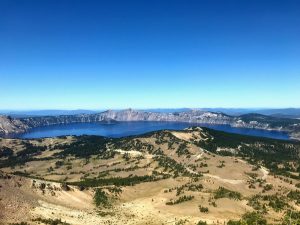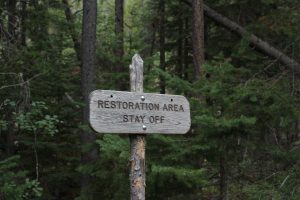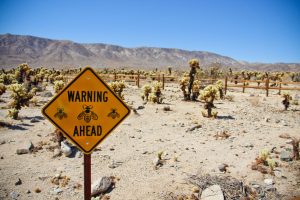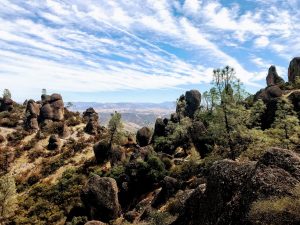National Parks and Climate Change in the Time of Coronavirus
By Kali Klotz, guest blogger

Oregon’s Crater Lake National Park (above) and Hetch Hetchy Reservoir in Yosemite (landing page) — photos by Kali Klotz
With everything being impacted by the current COVID-19 pandemic, our natural environment is no exception. Summer is pressing on, and our National Park System has begun to open back up on a park-by-park basis, attracting many people who are desperate to escape their bedroom walls and breathe in some fresh air.
The increase in visitation demand undeniably poses concerns, but I can’t help but feel optimistic about connecting folks to nature who might not otherwise choose a nearby national park as their summer vacation destination. Yet, here many are, with a burning desire to get out of the house and no better option than to seek time away in some of Earth’s most beautiful places.

Restoration sign — photo by Isaac Quick on Unsplash
Come to think of it, coronavirus isn’t the only thing affecting life as we know it. While we’ve been incredibly preoccupied by the immediate threat of mass illness, the threat of climate change is still very real and affecting our public lands and natural resources. In fact, a study shows that between 1985 and 2010, temperatures in our national parks rose twice as much as other regions of the country. The paper explains that “extensive parts of the national park area are in the Arctic, at high elevations, or on the arid southwestern US.” A rise in temperatures means dryer landscapes, longer warm seasons, less precipitation, and higher sea levels — all of which cause a rippling effect of changes across the 84 million acres of land that the agency oversees.
For instance, glaciers in Montana’s Glacier National Park have been reduced by up to 85% since 1966, while melting glaciers in Alaska are the largest single contributor to global sea level rise. On the Eastern coastline, sea level rise and storm surge threaten infrastructure and species protection in places like Maine’s Acadia National Park and Florida’s Everglades National Park. California’s Joshua Tree National Park is at risk of losing its namesake trees due to the unique relationship between them and the Yucca moth, which cannot survive in high temperatures.

Yucca moth sign in Joshua Tree National Park – photo by Gina Domenique on Unsplash
Not only are these concerns devastating because of the loss of innately valuable species and ecosystems, but we’re also losing the services they provide that humans depend on every day. Park watersheds provide drinking water; healthy forests sequester carbon and provide clean air; pollinating insects live in parks ecosystems; wetlands and estuaries maintain the health of river and marine life; snowpack and ice reflect the sun’s rays instead of absorbing them into our oceans or atmosphere, etc. The list goes on.
While it’s becoming increasingly obvious that climate change is impacting our everyday life, the fact that parks are experiencing effects on a more extreme level allows us a peek into the near future. When provided opportunities to witness life and crucial systems that are at risk outside our own built environments, we can better understand the situation and how to adapt to it. By connecting people to these vulnerable areas, national parks play an important role in bridging knowledge gaps and creating relationships between humans and our planet.
Fortunately, unlike some U.S. agencies, the National Park Service embraces the task of fighting climate change as well as proactively educating its visitors on the subject. In 2010, the agency established the Climate Change Response Program, which guides and supports efforts across the entire system to combat the issue. The program and its strategic plan have been formed around four main areas of emphasis: 1) science utilization, 2) adaptation to an uncertain future, 3) reduction of the agency’s carbon footprint, and 4) communication and education to the public and park employees about climate change. The plan states that “park units seek more (and more detailed) information about climate change and its impacts, as well as guidance in developing adaptation, mitigation, and communication strategies, particularly in light of continued visitor interest on the topic.”

Pinnacles National Park in California’s Salinas Valley — photo by Kali Klotz
One simple way to find more information about how your favorite spaces are being impacted is by visiting individual park websites. For example, Yosemite’s provides graphs on temperature increase over time, updates on research, and tips on what you can do to help mitigate changes. And if we’ve learned anything throughout our time with COVID-19, it’s that technology is amazingly helpful in keeping us all connected! There are plenty of resources accessible right from our homes that can keep us up to date on our favorite parks, or provide information about those still on the bucket list.
COVID-19 is very present now, but it’s vital that we remember climate change is as well. We’ve given up so much for this virus in order to save ourselves; it would be ignorant of us to disregard another very present crisis with the potential to be even more detrimental.
So if you do happen to find yourself planning a trip to Redwoods or Pinnacles, please stay safe, wear a face covering, respect the land, and take time to use park resources to discover more about our changing parks and the impact they have on us all.
